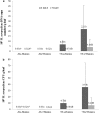Herbaspirillum seropedicae promotes maize growth but fails to control the maize leaf anthracnose
- PMID: 30804639
- PMCID: PMC6352535
- DOI: 10.1007/s12298-018-0616-2
Herbaspirillum seropedicae promotes maize growth but fails to control the maize leaf anthracnose
Abstract
Herbaspirillum seropedicae is an endophytic diazotrophic bacterium and a plant growth promoting bacteria. Colletotrichum graminicola causes the anthracnose, one of the most destructive maize diseases worldwide. The main objective of this work was to evaluate the effects of H. seropedicae SmR1 strain on the plant growth and leaf anthracnose of maize plants grown in substrate amended or not amended with humic substances. In the first assay, plants were pre-treated with H. seropedicae and inoculated with C. graminicola at 7, 14 and 21 days after treatment (DAT). In the second assay, plants were treated with H. seropedicae, grown in substrate amended with humic substances and inoculated at 3 and 7 DAT. The anthracnose severity was assessed by measurement of necrotic and chlorotic leaf area, and bacteria were quantified in leaves by quantitative PCR. H. seropedicae did not affect the disease severity in maize leaves, although it efficiently colonized the leaf tissues and it promoted maize leaf growth. Humic substances improved H. seropedicae colonization in maize.
Keywords: Anthracnose; Biocontrol agent; Colletotrichum graminicola; Diazotrophic bacteria; Herbaspirillum seropedicae; Plant growth promoting bacteria.
Conflict of interest statement
Compliance with ethical standardsThe authors declare that they have no conflict of interest.
Figures


Similar articles
-
Inoculation of Herbaspirillum seropedicae strain SmR1 increases biomass in maize roots DKB 390 variety in the early stages of plant development.Arch Microbiol. 2022 Jun 8;204(7):373. doi: 10.1007/s00203-022-02986-8. Arch Microbiol. 2022. PMID: 35672591
-
Real-time PCR quantification of the plant growth promoting bacteria Herbaspirillum seropedicae strain SmR1 in maize roots.Mol Biotechnol. 2014 Jul;56(7):660-70. doi: 10.1007/s12033-014-9742-4. Mol Biotechnol. 2014. PMID: 24563376
-
Evidence for the endophytic colonization of Phaseolus vulgaris (common bean) roots by the diazotroph Herbaspirillum seropedicae.Braz J Med Biol Res. 2011 Mar;44(3):182-5. doi: 10.1590/s0100-879x2011007500004. Epub 2011 Jan 14. Braz J Med Biol Res. 2011. PMID: 21243317
-
Maize Anthracnose Stalk Rot in the Genomic Era.Plant Dis. 2022 Sep;106(9):2281-2298. doi: 10.1094/PDIS-10-21-2147-FE. Epub 2022 Aug 12. Plant Dis. 2022. PMID: 35291814 Review.
-
Fungal Pathogenesis-Related Cell Wall Biogenesis, with Emphasis on the Maize Anthracnose Fungus Colletotrichum graminicola.Plants (Basel). 2022 Mar 23;11(7):849. doi: 10.3390/plants11070849. Plants (Basel). 2022. PMID: 35406829 Free PMC article. Review.
Cited by
-
Multiomic Approaches Reveal Hormonal Modulation and Nitrogen Uptake and Assimilation in the Initial Growth of Maize Inoculated with Herbaspirillum seropedicae.Plants (Basel). 2022 Dec 22;12(1):48. doi: 10.3390/plants12010048. Plants (Basel). 2022. PMID: 36616175 Free PMC article.
-
Common gene expression patterns are observed in rice roots during associations with plant growth-promoting bacteria, Herbaspirillum seropedicae and Azospirillum brasilense.Sci Rep. 2022 May 25;12(1):8827. doi: 10.1038/s41598-022-12285-3. Sci Rep. 2022. PMID: 35614083 Free PMC article.
-
Inoculation of Herbaspirillum seropedicae strain SmR1 increases biomass in maize roots DKB 390 variety in the early stages of plant development.Arch Microbiol. 2022 Jun 8;204(7):373. doi: 10.1007/s00203-022-02986-8. Arch Microbiol. 2022. PMID: 35672591
-
The Mexican giant maize of Jala landrace harbour plant-growth-promoting rhizospheric and endophytic bacteria.3 Biotech. 2021 Oct;11(10):447. doi: 10.1007/s13205-021-02983-6. Epub 2021 Sep 24. 3 Biotech. 2021. PMID: 34631348 Free PMC article.
References
-
- Alabouvette C, Lemanceau P, Steinberg C. Recent advances in the biological-control of Fusarium wilts. Pestic Sci. 1993;37:365–373.
-
- Alves GC, Videira SS, Urquiaga S, Reis VM. Differential plant growth promotion and nitrogen fixation in two genotypes of maize by several Herbaspirillum inoculants. Plant Soil. 2015;387:307–321.
-
- Babalola OO. Beneficial bacteria of agricultural importance. Biotechnol Lett. 2010;32:1559–1570. - PubMed
-
- Baldani VLD, Baldani JI, Dobereiner J. Inoculation of rice plants with the endophytic diazotrophs Herbaspirillum seropedicae and Burkholderia spp. Biol Fertil Soils. 2000;30:485–491.
LinkOut - more resources
Full Text Sources
Other Literature Sources
Molecular Biology Databases
